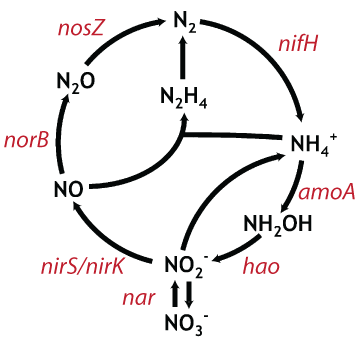Environmental control of microbial N2O fluxes and DIN loss in salt marsh sediments
 |
| Fig 1. Representation of the nitrogen cycle from Jetten (2008). Denitrification is the process that takes nitrate (NO3) to nitrogen gas (N2) which results in N2O production as well as the transformation of ammonium (NH4) to nitrate. |
Increases in anthropogenic nitrogen are known to alter the macro-ecology of salt marshes but it is the microbes that are the critical drivers of many of the subsidies these ecosystems provide. We are using high throughput sequencing, functional gene microarrays, and quantitative PCR to better understand how salt marsh sediment microbial communities respond to increased nitrogen loading.
Some of our current work in salt marshes takes place at the Great Sippewissett Salt Marsh, located in Falmouth, MA USA. Sippewissett Marsh has undergone a decades-long experiment in which fertilizer has been added to 10-meter diameter plots on a biweekly basis for more than 40 years. Many papers have been published with regard to the macro-ecology of the marsh plots (for a list of some recent publications relating to the Sippewissett Marsh plots click here). Much less is known regarding how this addition of fertilizer has altered the structure and function of the microbial community.
The sediments of salt marshes have very steep redox gradients that promote the removal of fixed nitrogen via the denitrification pathway (also frequently coupled with nitrification). Prior research suggested that in plots receiving large amounts of exogenous fertilizer there were higher rates of denitrification than in plots that did not receive exogenous fertilizers but understanding how changing environmental conditions alter the structure and function of the microbes responsible for this process lags behind our ability to measure rates of denitrification. Furthermore, many of the conditions that promote denitrification also promote the production of the potent greenhouse gas N2O (Fig 1). The concentrations of N2O are increasing in the atmosphere and, although agricultural soils are thought to be a primary source of N2O, many of the conditions that support N2O production also exist in salt marshes. This greenhouse gas is produced as a byproduct of the metabolisms of both nitrifying and denitrifying bacteria, but it is unclear under which conditions N2O is produced by the different groups of organisms. Thus, in addition to examining how the community composition of denitrifying bacteria change as a result of increased supply of nitrogen, we are using genetic techniques to decipher which groups of microorganisms are responsible for the production of N2O and how those communities change under different environmental stressors.
Papers associated with this work include:
Bowen, J. L., D. Weisman, M. Yasuda, A. Jayakumar, H. G. Morrison and B. B. Ward. 2015. Marine oxygen deficient zones harbor depauperate denitrifying communities compared to novel genetic diversity in coastal sediments. Microbial Ecology 70: 311-321.
Kearns, P. K., J. H. Angell, S. G. Feinman, and J. L. Bowen. 2015. Nutrient loading in the Great Sippewissett Marsh alters community composition and diversity of two reductases, norB and nosZ, in the denitrification pathway. Estuarine, Coastal, and Shelf Science 154: 39-47.
Bowen, J. L., A. R. Babbin, P. J. Kearns, and B. B. Ward. 2014. Connecting the dots: linking nitrogen cycle gene expression to nitrogen fluxes in marine sediment mesocosms. Frontiers in Microbiology 5, 429.
Ji, Q., A. R. Babbin, X. Peng, J. L. Bowen, and B. B. Ward. 2015. Nitrogen substrate dependent nitrous oxide cycling in salt marsh sediments. Journal of Marine Research 73: 71-92.
Peng, X., Q. Ji, J. H. Angell, P. J. Kearns, H. J. Yang, J. L. Bowen, and B. B. Ward. 2016. Long-term fertilization alters the relative importance of nitrate reduction pathways in salt marsh sediments. Journal of Geophysical Research. DOI: 10.1002/2016JG003484